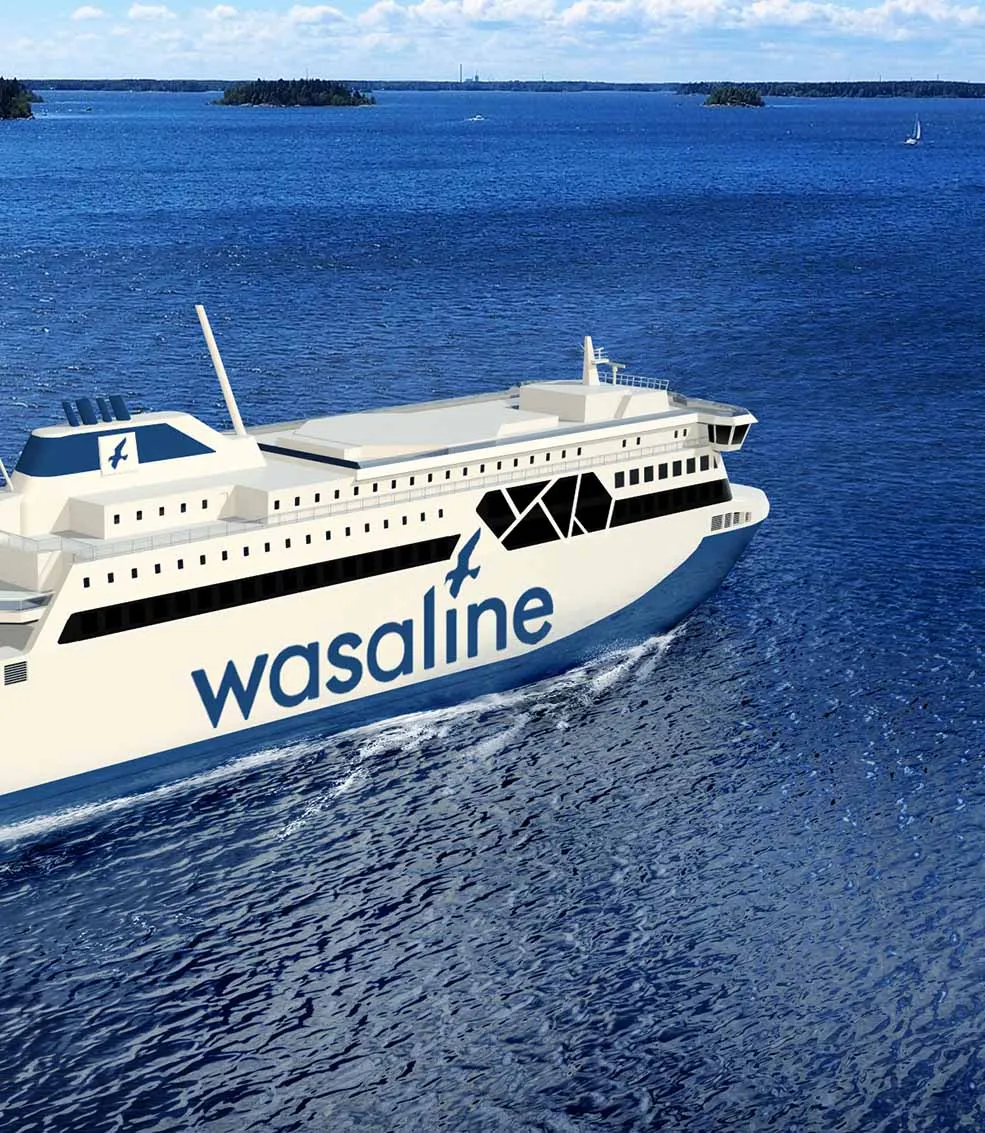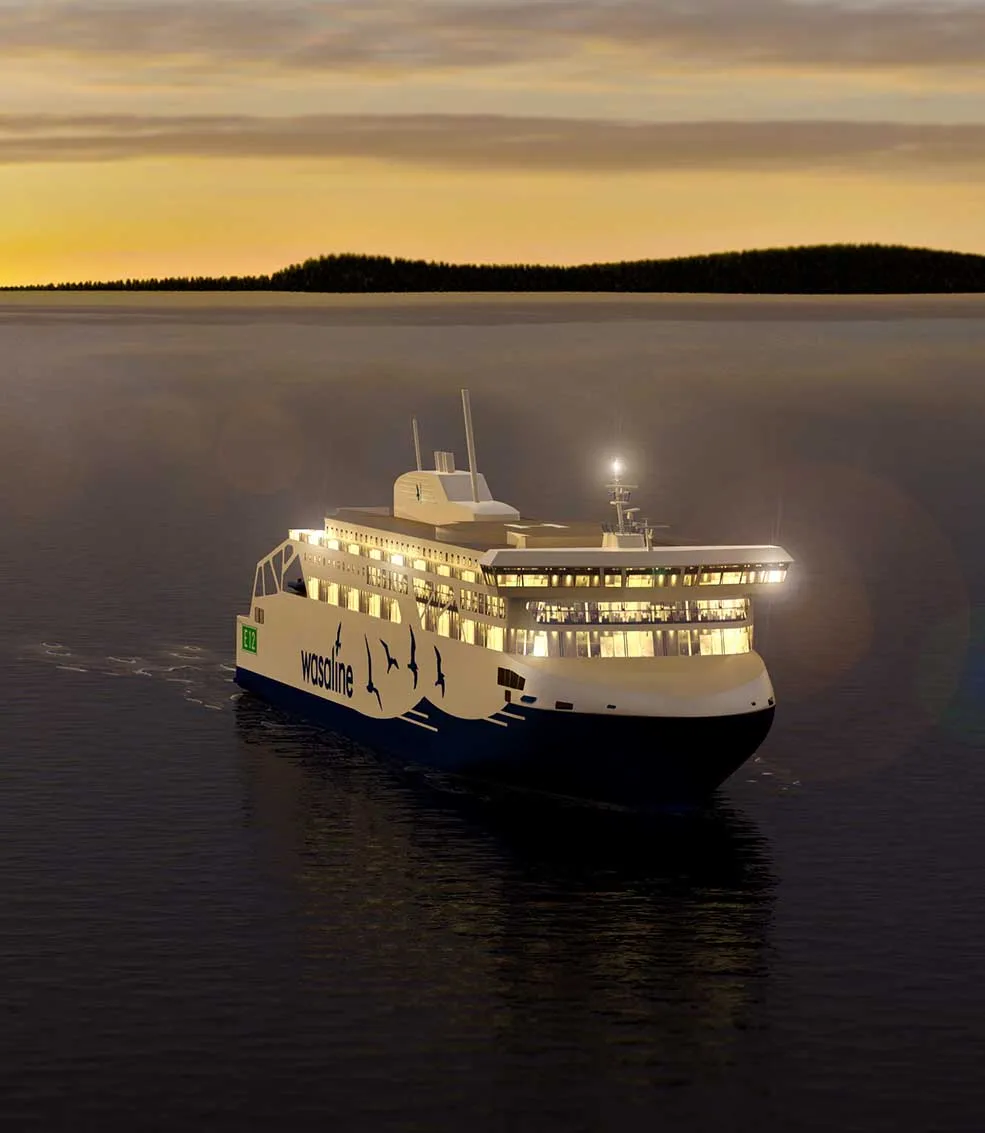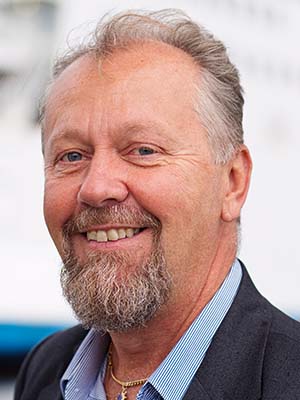New Wasaline ferry combines LNG, battery and sensor technologies
Wasaline, operator of the northernmost year-round ferry line in the world, will take delivery of a modern vessel in spring 2021 to replace their aging workhorse on the route. The new eco-friendly ship will help preserve the Kvarken World Heritage Site where it will operate.
Wasaline’s parent company, NLC Ferry, was founded in 2012, with the municipality of Umeå in Sweden and the city of Vaasa in Finland as owners. The new company’s strategy was to strengthen the focus on passenger traffic between the two towns and to improve the cargo offering on the line. The team from NLC Ferry, together with Christer Schoug of BoCS Consulting and Ari Huttunen of Foreship, initiated a process that culminated in the signing of a newbuilding contract with Rauma Marine Constructions in January 2019.
New thinking to match ambitious goals
The new vessel will be loaded with leading-edge innovation, making the project development and yard procurement process somewhat demanding, reports Peter Ståhlberg, Managing Director of Wasaline. Nonetheless, he has praise for the good cooperation between stakeholders: “Despite this being a complex vessel, we were surprised at how unbureaucratic the bureaucracy of our public owners turned out to be. They were very engaged, and with the same ambitions as we had.”
Design guidelines for the new vessel were indeed ambitious for a small operator, with Wasaline themselves stipulating the main criteria, including dual-fuel engines with LNG as the primary fuel, and compliance with Ice Class 1A Super. The high ice class will enable the ferry to operate without icebreaking assistance, an essential feature in the Gulf of Bothnia with its heavy winter ice conditions. The vessel will also incorporate the “living lab” concept for ice research, done in partnership with the University of Vaasa.
We are confident that all the features together will make this newbuilding one of the most environmentally friendly ferries on the water. Our focus has been on innovation, technology demonstrators and rapid introduction of new solutions and products. The design supports flexibility and the ability to maintain a high level of innovation through the lifespan of the vessel, not just upon delivery.

A smarter, cleaner, quieter ferry
The new ferry will be a truly smart ship, employing Wärtsilä imbedded sensor engine technology, and feeding information from over 1,000 outputs from the engine alone to their Smart Hub operational support centre, which is located just down the street from Wasaline’s office in Vaasa. “We had planned for a smart ship from the design phase, including a remote-ready engine room when that technology matures,” says Schoug. A glass wall will allow viewing of the engine room without entering the hazardous environment.
LNG will be supplied in Vaasa, but the company is looking to biogas as a future fuel, as the ports of Umeå and Vaasa plan to become carbon-neutral in the near future. Shore power will be available in both ports, with the port in Umeå scheduled for upgrading along the entire logistics chain. Batteries will supply power for peak shaving and support of hotel loads, but also for propulsion during entry and exit to and from the ports. “All this will mean less noise, and fewer emissions,” says Schoug.

Long-term plans for sustainability
“We are confident that all the features together will make this newbuilding one of the most environmentally friendly ferries on the water,” says Ståhlberg. “Our focus has been on innovation, technology demonstrators and rapid introduction of new solutions and products. The design supports flexibility and the ability to maintain a high level of innovation through the lifespan of the vessel, not just upon delivery.”
He emphasizes that Wasaline intends to operate as clean a ship as practically possible, but acknowledges that strict regulations requiring cleaner operations were a key factor in the design configuration. “Finland has the toughest regulations, but there is fundamental consensus between Sweden and Finland, and between the Scandinavian countries in general.”
With such a sophisticated vessel, the choice of yard was critical for the success of the project. “There were 12 yards involved at the start, and we ended up with two in tight competition,” says Ståhlberg. Following an extensive evaluation process in keeping with EU procurement rules, Rauma Marine Constructions eventually won the contract. Being located close to Wasaline did not receive the heaviest weighting, he relates. “They won because they had the facilities and knowledge in place. We are very happy to be working with Rauma. It’s a tight schedule but they have the building capacity. We believe this will be a showcase for the entire industry, and Finnish shipbuilding will be taken to a higher level with this project.”
David Wendel, Key Account Manager at DNV GL – Maritime’s region North Europe, concurs. “This is a milestone project for the owner, but also for the yard. Building advanced vessels keeps yards up to speed on the latest technologies and construction methods and enhances their attractiveness on the market. DNV GL is very pleased to be able to assist Wasaline and Rauma in this important effort.”

Ferry industry facing hurdles
Despite his optimism for the new ferry, Ståhlberg has concerns for the ferry industry. “For one thing, the fleet is old. There has been little or no investment for a long time, but those who act now will succeed. Those who wait will be in trouble.” He sees an overheated market as another challenge. “A lack of hungry suppliers pushes prices up, and delivery times become longer. A short schedule like ours is a challenge for yards, not least because the supply chain is overheated.”
Industry consolidation is another issue, he believes. “Bigger companies can dictate to smaller companies, and manning becomes an issue too. Availability is tight due to heavy demand, and the bigger yards attract the bulk of workers. All the suppliers are consumed by the cruise boom, and this affects the whole value chain, including crewing.”
Christer Schoug maintains that changing business models in response to a shifting financial risk picture also pose challenges. “Historically, the yards had their own employees, and they could build their knowledge over the years. Now many yards are typically a small group of people supported by subcontractors who take their skill and knowledge with them when their work is completed. Yards simply have to hope that they can source good suppliers, and that they can secure them for consecutive projects in order to benefit from their experience.”
With many years in the industry, Schoug has a tried-and-tested method of dealing with the challenges inherent in building ships: “You have to define what you want and participate actively in the process at every step. If you want to get what you order, you have to pay attention. In the end, you get what you inspect.”
All in all, Peter Ståhlberg is pleased with the progress Wasaline has been able to make. “Even as a small company, we are at the top in innovation. I think we can be proud of that accomplishment.”
- Key image - Kvarken Link
- Side image 2 - Kvarken Link
- Text image 4 - Kvarken Link
View image copyright information


